LGACOM406A - Legislation Breaches Investigation and Documentation Task
VerifiedAdded on 2023/06/12
|10
|2530
|354
Homework Assignment
AI Summary
This assignment solution focuses on investigating alleged breaches of legislation, specifically local laws, and preparing relevant workplace documentation, aligning with the LGACOM406A unit. The student assumes the role of a Moreland Council Planning Authorised Enforcement Officer and researches their job description, including required qualifications and relevant legislation. The assignment requires the student to identify and describe a breach of law based on a given scenario involving hazardous chemicals stored improperly in a warehouse, referencing the Work Health and Safety Act 2011. The student must also locate and attach a copy of the breached law/regulation. The solution provides an overview of assessment tasks, instructions, and criteria, ensuring compliance with assessment principles and rules of evidence, and emphasizes academic integrity.
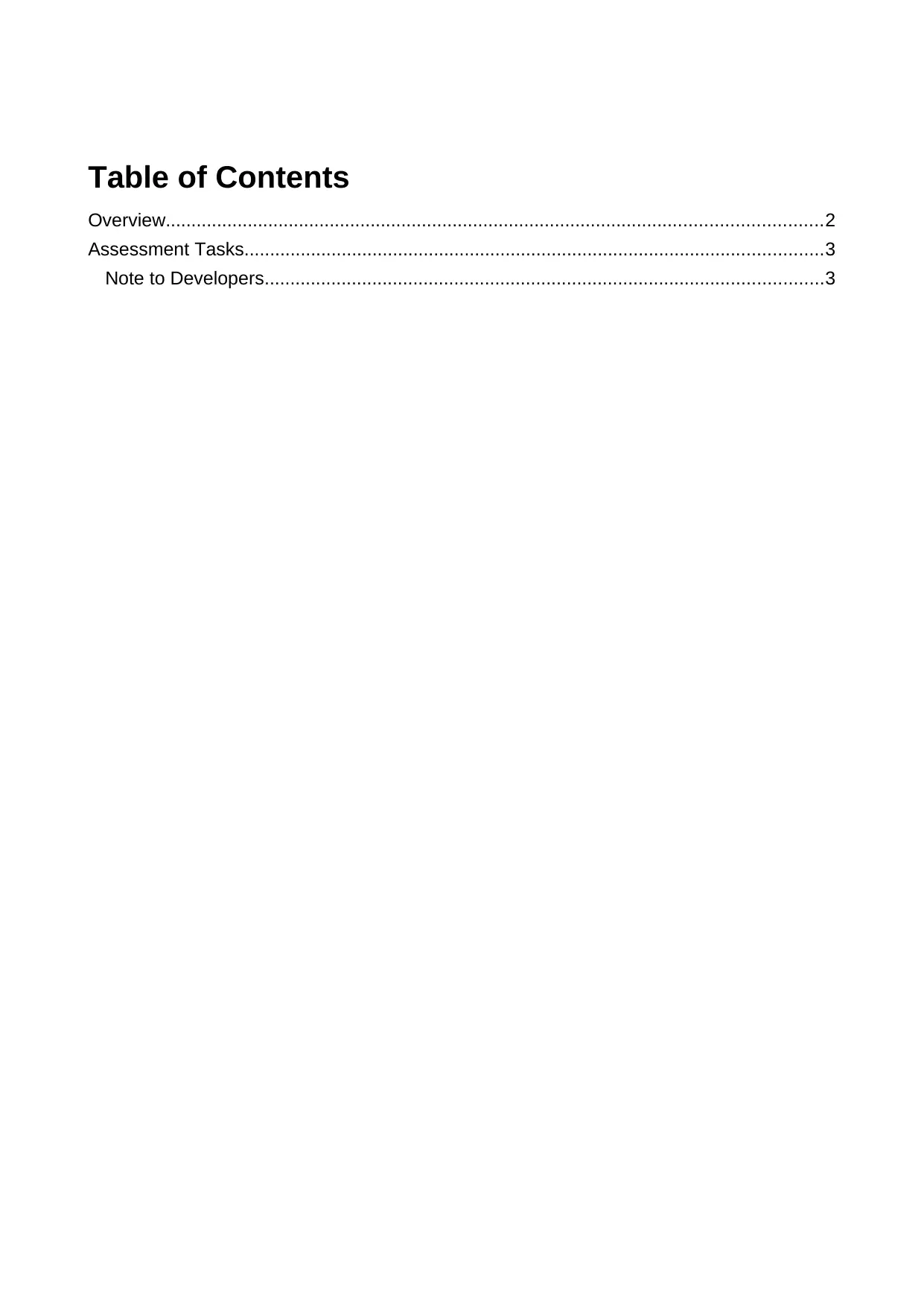
Table of Contents
Overview................................................................................................................................2
Assessment Tasks.................................................................................................................3
Note to Developers.............................................................................................................3
Overview................................................................................................................................2
Assessment Tasks.................................................................................................................3
Note to Developers.............................................................................................................3
Paraphrase This Document
Need a fresh take? Get an instant paraphrase of this document with our AI Paraphraser
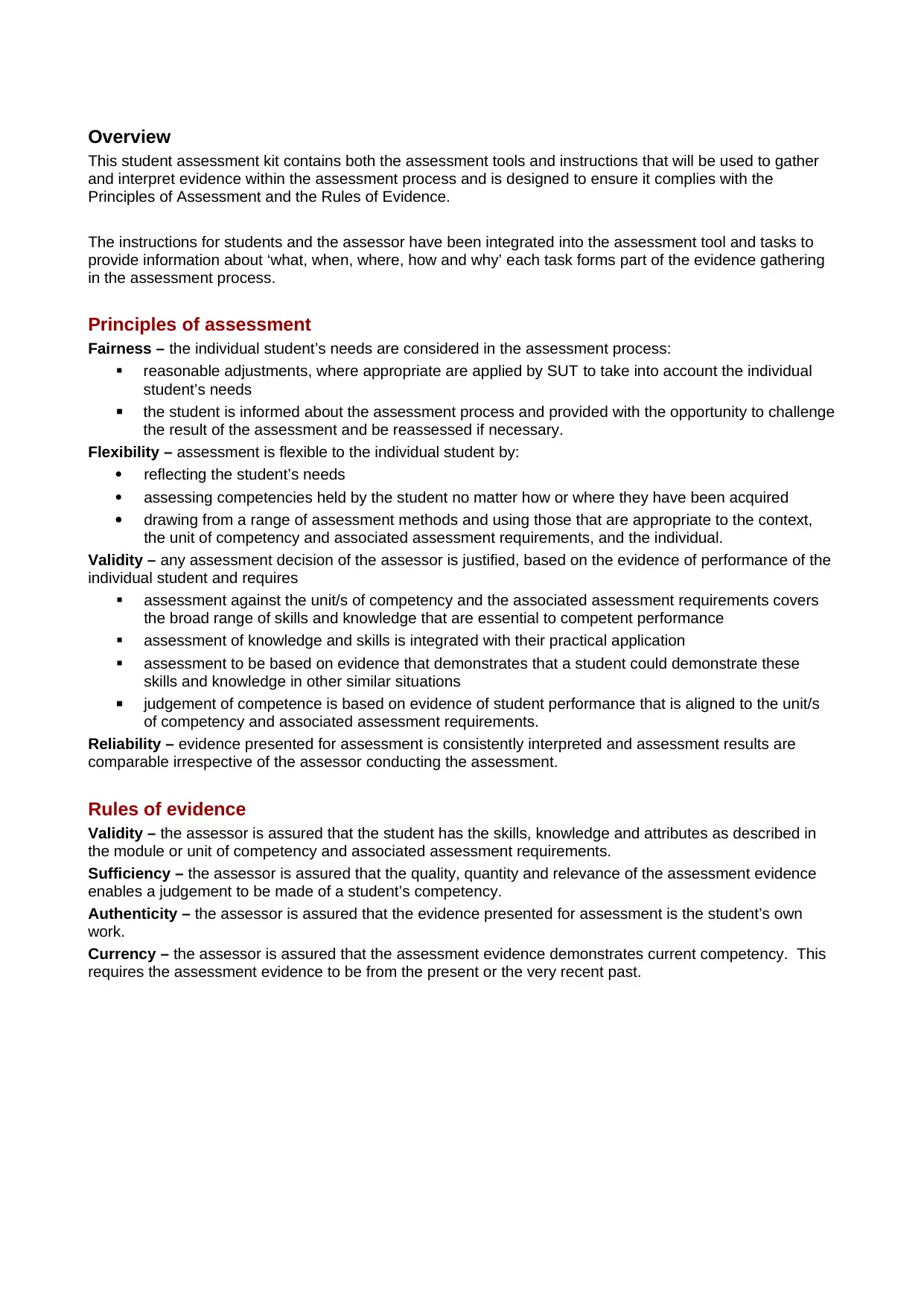
Overview
This student assessment kit contains both the assessment tools and instructions that will be used to gather
and interpret evidence within the assessment process and is designed to ensure it complies with the
Principles of Assessment and the Rules of Evidence.
The instructions for students and the assessor have been integrated into the assessment tool and tasks to
provide information about ‘what, when, where, how and why’ each task forms part of the evidence gathering
in the assessment process.
Principles of assessment
Fairness – the individual student’s needs are considered in the assessment process:
reasonable adjustments, where appropriate are applied by SUT to take into account the individual
student’s needs
the student is informed about the assessment process and provided with the opportunity to challenge
the result of the assessment and be reassessed if necessary.
Flexibility – assessment is flexible to the individual student by:
reflecting the student’s needs
assessing competencies held by the student no matter how or where they have been acquired
drawing from a range of assessment methods and using those that are appropriate to the context,
the unit of competency and associated assessment requirements, and the individual.
Validity – any assessment decision of the assessor is justified, based on the evidence of performance of the
individual student and requires
assessment against the unit/s of competency and the associated assessment requirements covers
the broad range of skills and knowledge that are essential to competent performance
assessment of knowledge and skills is integrated with their practical application
assessment to be based on evidence that demonstrates that a student could demonstrate these
skills and knowledge in other similar situations
judgement of competence is based on evidence of student performance that is aligned to the unit/s
of competency and associated assessment requirements.
Reliability – evidence presented for assessment is consistently interpreted and assessment results are
comparable irrespective of the assessor conducting the assessment.
Rules of evidence
Validity – the assessor is assured that the student has the skills, knowledge and attributes as described in
the module or unit of competency and associated assessment requirements.
Sufficiency – the assessor is assured that the quality, quantity and relevance of the assessment evidence
enables a judgement to be made of a student’s competency.
Authenticity – the assessor is assured that the evidence presented for assessment is the student’s own
work.
Currency – the assessor is assured that the assessment evidence demonstrates current competency. This
requires the assessment evidence to be from the present or the very recent past.
This student assessment kit contains both the assessment tools and instructions that will be used to gather
and interpret evidence within the assessment process and is designed to ensure it complies with the
Principles of Assessment and the Rules of Evidence.
The instructions for students and the assessor have been integrated into the assessment tool and tasks to
provide information about ‘what, when, where, how and why’ each task forms part of the evidence gathering
in the assessment process.
Principles of assessment
Fairness – the individual student’s needs are considered in the assessment process:
reasonable adjustments, where appropriate are applied by SUT to take into account the individual
student’s needs
the student is informed about the assessment process and provided with the opportunity to challenge
the result of the assessment and be reassessed if necessary.
Flexibility – assessment is flexible to the individual student by:
reflecting the student’s needs
assessing competencies held by the student no matter how or where they have been acquired
drawing from a range of assessment methods and using those that are appropriate to the context,
the unit of competency and associated assessment requirements, and the individual.
Validity – any assessment decision of the assessor is justified, based on the evidence of performance of the
individual student and requires
assessment against the unit/s of competency and the associated assessment requirements covers
the broad range of skills and knowledge that are essential to competent performance
assessment of knowledge and skills is integrated with their practical application
assessment to be based on evidence that demonstrates that a student could demonstrate these
skills and knowledge in other similar situations
judgement of competence is based on evidence of student performance that is aligned to the unit/s
of competency and associated assessment requirements.
Reliability – evidence presented for assessment is consistently interpreted and assessment results are
comparable irrespective of the assessor conducting the assessment.
Rules of evidence
Validity – the assessor is assured that the student has the skills, knowledge and attributes as described in
the module or unit of competency and associated assessment requirements.
Sufficiency – the assessor is assured that the quality, quantity and relevance of the assessment evidence
enables a judgement to be made of a student’s competency.
Authenticity – the assessor is assured that the evidence presented for assessment is the student’s own
work.
Currency – the assessor is assured that the assessment evidence demonstrates current competency. This
requires the assessment evidence to be from the present or the very recent past.

Assessment Tasks
The following section includes the Assessment tasks that you are required to complete.
Note to Developers
Delete all red developer instructions text in the templates as you progress.
Guidance to assessing each assessment task must be included and benchmark responses and
exemplar marking criteria are provided for each question and tasks in red text.
You can copy templates as required to suit your unit/cluster assessment tasks and methods.
Complete all highlighted areas in blue text to ensure information is complete under each heading and
section.
Add any templates for tasks by copy and paste into the relevant section i.e. in numerical order of
assessment tasks for the unit or cluster
Remove any templates not required for your unit/cluster assessments.
The completed kit should include all assessment tasks for your unit/cluster as a completed document
to be stored on your departments G Drive. You must include version control and applicable file naming conventions to store and maintain your
documents.
Assessment Requirements
Purpose of the task:
This assessment is designed to gather evidence of your knowledge required to identify and investigate
alleged breaches of local laws. You will be working through the process of an investigation, from initial
identification of a breach of a law through to preparing to take further action.
Instructions:
Students are required to answer all questions correctly to achieve satisfactory outcome.
For each response students must reference the source of their information, using the APA referencing
system. This demonstrates their research skills as required by this unit.
Assessment Conditions
Time: You are expected to complete the assessment in 4-6 hours.
Unit Details
Code(s) Title(s)
LGACOM406A Investigate alleged breaches of legislation and prepare
documentation
Assessment Task Details
Number Assessment Method Type
AT1 Workplace
documentation (Written
Statement)
Questioning ☒ Written
The following section includes the Assessment tasks that you are required to complete.
Note to Developers
Delete all red developer instructions text in the templates as you progress.
Guidance to assessing each assessment task must be included and benchmark responses and
exemplar marking criteria are provided for each question and tasks in red text.
You can copy templates as required to suit your unit/cluster assessment tasks and methods.
Complete all highlighted areas in blue text to ensure information is complete under each heading and
section.
Add any templates for tasks by copy and paste into the relevant section i.e. in numerical order of
assessment tasks for the unit or cluster
Remove any templates not required for your unit/cluster assessments.
The completed kit should include all assessment tasks for your unit/cluster as a completed document
to be stored on your departments G Drive. You must include version control and applicable file naming conventions to store and maintain your
documents.
Assessment Requirements
Purpose of the task:
This assessment is designed to gather evidence of your knowledge required to identify and investigate
alleged breaches of local laws. You will be working through the process of an investigation, from initial
identification of a breach of a law through to preparing to take further action.
Instructions:
Students are required to answer all questions correctly to achieve satisfactory outcome.
For each response students must reference the source of their information, using the APA referencing
system. This demonstrates their research skills as required by this unit.
Assessment Conditions
Time: You are expected to complete the assessment in 4-6 hours.
Unit Details
Code(s) Title(s)
LGACOM406A Investigate alleged breaches of legislation and prepare
documentation
Assessment Task Details
Number Assessment Method Type
AT1 Workplace
documentation (Written
Statement)
Questioning ☒ Written
⊘ This is a preview!⊘
Do you want full access?
Subscribe today to unlock all pages.

Trusted by 1+ million students worldwide

Location and environment: Students will complete this assessment in both class time and their own time.
This is an open book assessment where students can use their learning materials as a reference.
Authenticity: It must be your own work and written in your own words. When quoting specific references,
you must acknowledge the source. Evidence of plagiarism or cheating will result in the assessment being
assessed as unsatisfactory and further investigation will occur.
Resources and Equipment Required
Students will need to provide:
Computer, with Word and an Internet Connection
The assessor will provide:
The assessment task cover sheet either in hard copy or electronically in Canvas
Relevant links and resources in Canvas
Resubmission or Re-sit Outcome
Where an answer is deemed unsatisfactory after the first attempt, up to two resubmission or re-sit attempts
will be allowed. The attempt may occur immediately after the assessment if the assessor believes this is
suitable. Alternatively, an additional attempt may be provided at a later stage where the assessor identifies
a need for you to undertake further training and preparation.
The assessor is required to provide you feedback detailing what was Unsatisfactory (US) and what the you
need to do to achieve a Satisfactory (S) outcome using the student feedback record. You will be required
to answer the questions that were incorrect.
Assessment Outcome
To successfully achieve this assessment, you are required to complete all questions correctly to achieve a
Satisfactory (S) outcome.
The outcome of this assessment will contribute to the evidence used in the final decision to achieve
competency for this unit.
Assessment Submission
To meet the requirements of this assessment you will be required to submit the following either in hard
copy or via Canvas to your assessor:
Assessment task cover sheet
Completed responses to all questions
This is an open book assessment where students can use their learning materials as a reference.
Authenticity: It must be your own work and written in your own words. When quoting specific references,
you must acknowledge the source. Evidence of plagiarism or cheating will result in the assessment being
assessed as unsatisfactory and further investigation will occur.
Resources and Equipment Required
Students will need to provide:
Computer, with Word and an Internet Connection
The assessor will provide:
The assessment task cover sheet either in hard copy or electronically in Canvas
Relevant links and resources in Canvas
Resubmission or Re-sit Outcome
Where an answer is deemed unsatisfactory after the first attempt, up to two resubmission or re-sit attempts
will be allowed. The attempt may occur immediately after the assessment if the assessor believes this is
suitable. Alternatively, an additional attempt may be provided at a later stage where the assessor identifies
a need for you to undertake further training and preparation.
The assessor is required to provide you feedback detailing what was Unsatisfactory (US) and what the you
need to do to achieve a Satisfactory (S) outcome using the student feedback record. You will be required
to answer the questions that were incorrect.
Assessment Outcome
To successfully achieve this assessment, you are required to complete all questions correctly to achieve a
Satisfactory (S) outcome.
The outcome of this assessment will contribute to the evidence used in the final decision to achieve
competency for this unit.
Assessment Submission
To meet the requirements of this assessment you will be required to submit the following either in hard
copy or via Canvas to your assessor:
Assessment task cover sheet
Completed responses to all questions
Paraphrase This Document
Need a fresh take? Get an instant paraphrase of this document with our AI Paraphraser
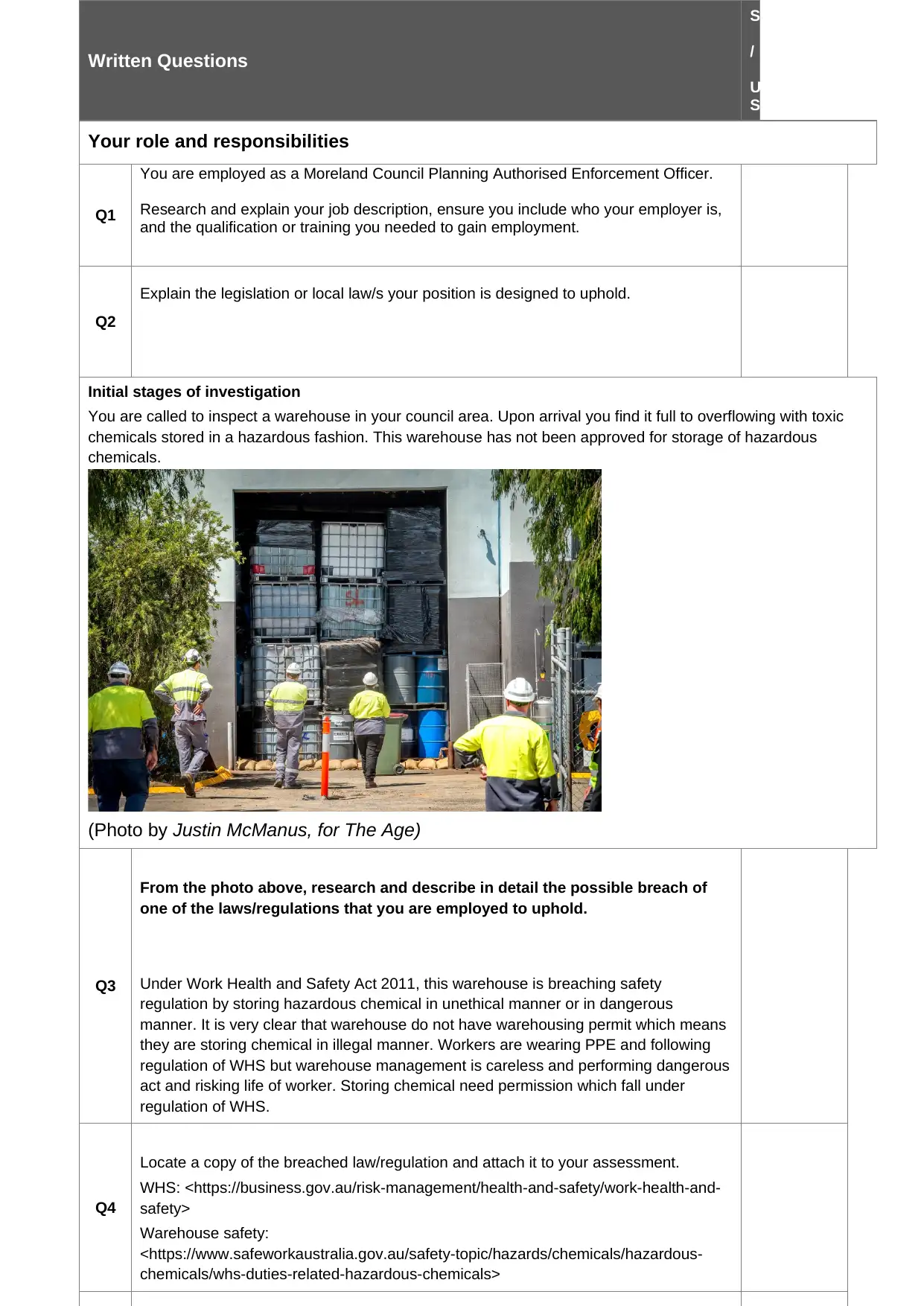
Written Questions
S
/
U
S
Your role and responsibilities
Q1
You are employed as a Moreland Council Planning Authorised Enforcement Officer.
Research and explain your job description, ensure you include who your employer is,
and the qualification or training you needed to gain employment.
Q2
Explain the legislation or local law/s your position is designed to uphold.
Initial stages of investigation
You are called to inspect a warehouse in your council area. Upon arrival you find it full to overflowing with toxic
chemicals stored in a hazardous fashion. This warehouse has not been approved for storage of hazardous
chemicals.
(Photo by Justin McManus, for The Age)
Q3
From the photo above, research and describe in detail the possible breach of
one of the laws/regulations that you are employed to uphold.
Under Work Health and Safety Act 2011, this warehouse is breaching safety
regulation by storing hazardous chemical in unethical manner or in dangerous
manner. It is very clear that warehouse do not have warehousing permit which means
they are storing chemical in illegal manner. Workers are wearing PPE and following
regulation of WHS but warehouse management is careless and performing dangerous
act and risking life of worker. Storing chemical need permission which fall under
regulation of WHS.
Q4
Locate a copy of the breached law/regulation and attach it to your assessment.
WHS: <https://business.gov.au/risk-management/health-and-safety/work-health-and-
safety>
Warehouse safety:
<https://www.safeworkaustralia.gov.au/safety-topic/hazards/chemicals/hazardous-
chemicals/whs-duties-related-hazardous-chemicals>
S
/
U
S
Your role and responsibilities
Q1
You are employed as a Moreland Council Planning Authorised Enforcement Officer.
Research and explain your job description, ensure you include who your employer is,
and the qualification or training you needed to gain employment.
Q2
Explain the legislation or local law/s your position is designed to uphold.
Initial stages of investigation
You are called to inspect a warehouse in your council area. Upon arrival you find it full to overflowing with toxic
chemicals stored in a hazardous fashion. This warehouse has not been approved for storage of hazardous
chemicals.
(Photo by Justin McManus, for The Age)
Q3
From the photo above, research and describe in detail the possible breach of
one of the laws/regulations that you are employed to uphold.
Under Work Health and Safety Act 2011, this warehouse is breaching safety
regulation by storing hazardous chemical in unethical manner or in dangerous
manner. It is very clear that warehouse do not have warehousing permit which means
they are storing chemical in illegal manner. Workers are wearing PPE and following
regulation of WHS but warehouse management is careless and performing dangerous
act and risking life of worker. Storing chemical need permission which fall under
regulation of WHS.
Q4
Locate a copy of the breached law/regulation and attach it to your assessment.
WHS: <https://business.gov.au/risk-management/health-and-safety/work-health-and-
safety>
Warehouse safety:
<https://www.safeworkaustralia.gov.au/safety-topic/hazards/chemicals/hazardous-
chemicals/whs-duties-related-hazardous-chemicals>

⊘ This is a preview!⊘
Do you want full access?
Subscribe today to unlock all pages.

Trusted by 1+ million students worldwide

Assessment Task Outcome (Assessor use only)
Assessors: Please return this Feedback and Assessment Task Outcome section to the student. A copy
must be retained on the student’s file with the evidence, or feedback will be provided in Canvas and kept
in the student’s file with the evidence.
To satisfactorily complete this assessment task, you are required to have answered all written questions
correctly. The assessor must provide you with written feedback specific to their performance. Where the
performance outcome is:
Satisfactory (S) – the assessor will summarise the findings as this will allow you to understand
why this outcome was achieved.
Unsatisfactory (US) – the assessor will provide reasons as to why you were deemed US and
include information about the areas needing improvement and where further evidence is required.
Where you are granted the opportunity to re-sit or resubmit, you will be provided re-sit or resubmission
date.
Assessors: Please return this Feedback and Assessment Task Outcome section to the student. A copy
must be retained on the student’s file with the evidence, or feedback will be provided in Canvas and kept
in the student’s file with the evidence.
To satisfactorily complete this assessment task, you are required to have answered all written questions
correctly. The assessor must provide you with written feedback specific to their performance. Where the
performance outcome is:
Satisfactory (S) – the assessor will summarise the findings as this will allow you to understand
why this outcome was achieved.
Unsatisfactory (US) – the assessor will provide reasons as to why you were deemed US and
include information about the areas needing improvement and where further evidence is required.
Where you are granted the opportunity to re-sit or resubmit, you will be provided re-sit or resubmission
date.
Paraphrase This Document
Need a fresh take? Get an instant paraphrase of this document with our AI Paraphraser
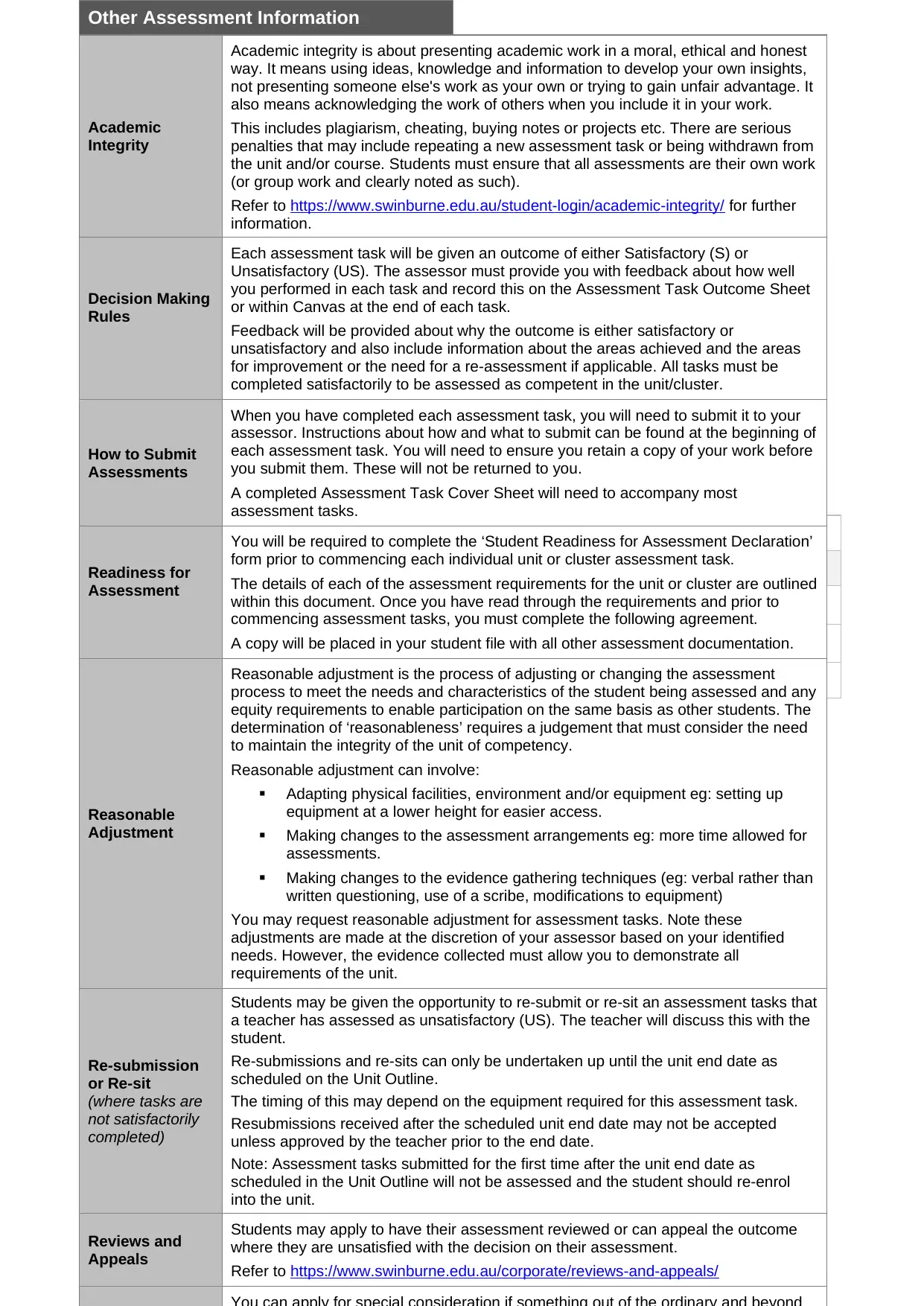
Feedback to
Student
Attempt 1
Attempt 2
Attempt 3
Assessment Task No Assessment Method Questioning - Written
Result Attempt 1 Attempt 2 Attempt 3
Satisfactory ☐ ☐ ☐
Unsatisfactory ☐ ☐ ☐
Date
The assessor is to
complete the following
declaration once the final
assessment decision for
this task has been made.
Assessor Declaration
I declare that I have
provided appropriate
feedback and
undertaken an
assessment process
which complies with the
principles of assessment
and the rules of
evidence.
Assessor Name Assessor Signature
D
a
t
e
Other Assessment Information
Academic
Integrity
Academic integrity is about presenting academic work in a moral, ethical and honest
way. It means using ideas, knowledge and information to develop your own insights,
not presenting someone else's work as your own or trying to gain unfair advantage. It
also means acknowledging the work of others when you include it in your work.
This includes plagiarism, cheating, buying notes or projects etc. There are serious
penalties that may include repeating a new assessment task or being withdrawn from
the unit and/or course. Students must ensure that all assessments are their own work
(or group work and clearly noted as such).
Refer to https://www.swinburne.edu.au/student-login/academic-integrity/ for further
information.
Decision Making
Rules
Each assessment task will be given an outcome of either Satisfactory (S) or
Unsatisfactory (US). The assessor must provide you with feedback about how well
you performed in each task and record this on the Assessment Task Outcome Sheet
or within Canvas at the end of each task.
Feedback will be provided about why the outcome is either satisfactory or
unsatisfactory and also include information about the areas achieved and the areas
for improvement or the need for a re-assessment if applicable. All tasks must be
completed satisfactorily to be assessed as competent in the unit/cluster.
How to Submit
Assessments
When you have completed each assessment task, you will need to submit it to your
assessor. Instructions about how and what to submit can be found at the beginning of
each assessment task. You will need to ensure you retain a copy of your work before
you submit them. These will not be returned to you.
A completed Assessment Task Cover Sheet will need to accompany most
assessment tasks.
Readiness for
Assessment
You will be required to complete the ‘Student Readiness for Assessment Declaration’
form prior to commencing each individual unit or cluster assessment task.
The details of each of the assessment requirements for the unit or cluster are outlined
within this document. Once you have read through the requirements and prior to
commencing assessment tasks, you must complete the following agreement.
A copy will be placed in your student file with all other assessment documentation.
Reasonable
Adjustment
Reasonable adjustment is the process of adjusting or changing the assessment
process to meet the needs and characteristics of the student being assessed and any
equity requirements to enable participation on the same basis as other students. The
determination of ‘reasonableness’ requires a judgement that must consider the need
to maintain the integrity of the unit of competency.
Reasonable adjustment can involve:
Adapting physical facilities, environment and/or equipment eg: setting up
equipment at a lower height for easier access.
Making changes to the assessment arrangements eg: more time allowed for
assessments.
Making changes to the evidence gathering techniques (eg: verbal rather than
written questioning, use of a scribe, modifications to equipment)
You may request reasonable adjustment for assessment tasks. Note these
adjustments are made at the discretion of your assessor based on your identified
needs. However, the evidence collected must allow you to demonstrate all
requirements of the unit.
Re-submission
or Re-sit
(where tasks are
not satisfactorily
completed)
Students may be given the opportunity to re-submit or re-sit an assessment tasks that
a teacher has assessed as unsatisfactory (US). The teacher will discuss this with the
student.
Re-submissions and re-sits can only be undertaken up until the unit end date as
scheduled on the Unit Outline.
The timing of this may depend on the equipment required for this assessment task.
Resubmissions received after the scheduled unit end date may not be accepted
unless approved by the teacher prior to the end date.
Note: Assessment tasks submitted for the first time after the unit end date as
scheduled in the Unit Outline will not be assessed and the student should re-enrol
into the unit.
Reviews and
Appeals
Students may apply to have their assessment reviewed or can appeal the outcome
where they are unsatisfied with the decision on their assessment.
Refer to https://www.swinburne.edu.au/corporate/reviews-and-appeals/
Student
Attempt 1
Attempt 2
Attempt 3
Assessment Task No Assessment Method Questioning - Written
Result Attempt 1 Attempt 2 Attempt 3
Satisfactory ☐ ☐ ☐
Unsatisfactory ☐ ☐ ☐
Date
The assessor is to
complete the following
declaration once the final
assessment decision for
this task has been made.
Assessor Declaration
I declare that I have
provided appropriate
feedback and
undertaken an
assessment process
which complies with the
principles of assessment
and the rules of
evidence.
Assessor Name Assessor Signature
D
a
t
e
Other Assessment Information
Academic
Integrity
Academic integrity is about presenting academic work in a moral, ethical and honest
way. It means using ideas, knowledge and information to develop your own insights,
not presenting someone else's work as your own or trying to gain unfair advantage. It
also means acknowledging the work of others when you include it in your work.
This includes plagiarism, cheating, buying notes or projects etc. There are serious
penalties that may include repeating a new assessment task or being withdrawn from
the unit and/or course. Students must ensure that all assessments are their own work
(or group work and clearly noted as such).
Refer to https://www.swinburne.edu.au/student-login/academic-integrity/ for further
information.
Decision Making
Rules
Each assessment task will be given an outcome of either Satisfactory (S) or
Unsatisfactory (US). The assessor must provide you with feedback about how well
you performed in each task and record this on the Assessment Task Outcome Sheet
or within Canvas at the end of each task.
Feedback will be provided about why the outcome is either satisfactory or
unsatisfactory and also include information about the areas achieved and the areas
for improvement or the need for a re-assessment if applicable. All tasks must be
completed satisfactorily to be assessed as competent in the unit/cluster.
How to Submit
Assessments
When you have completed each assessment task, you will need to submit it to your
assessor. Instructions about how and what to submit can be found at the beginning of
each assessment task. You will need to ensure you retain a copy of your work before
you submit them. These will not be returned to you.
A completed Assessment Task Cover Sheet will need to accompany most
assessment tasks.
Readiness for
Assessment
You will be required to complete the ‘Student Readiness for Assessment Declaration’
form prior to commencing each individual unit or cluster assessment task.
The details of each of the assessment requirements for the unit or cluster are outlined
within this document. Once you have read through the requirements and prior to
commencing assessment tasks, you must complete the following agreement.
A copy will be placed in your student file with all other assessment documentation.
Reasonable
Adjustment
Reasonable adjustment is the process of adjusting or changing the assessment
process to meet the needs and characteristics of the student being assessed and any
equity requirements to enable participation on the same basis as other students. The
determination of ‘reasonableness’ requires a judgement that must consider the need
to maintain the integrity of the unit of competency.
Reasonable adjustment can involve:
Adapting physical facilities, environment and/or equipment eg: setting up
equipment at a lower height for easier access.
Making changes to the assessment arrangements eg: more time allowed for
assessments.
Making changes to the evidence gathering techniques (eg: verbal rather than
written questioning, use of a scribe, modifications to equipment)
You may request reasonable adjustment for assessment tasks. Note these
adjustments are made at the discretion of your assessor based on your identified
needs. However, the evidence collected must allow you to demonstrate all
requirements of the unit.
Re-submission
or Re-sit
(where tasks are
not satisfactorily
completed)
Students may be given the opportunity to re-submit or re-sit an assessment tasks that
a teacher has assessed as unsatisfactory (US). The teacher will discuss this with the
student.
Re-submissions and re-sits can only be undertaken up until the unit end date as
scheduled on the Unit Outline.
The timing of this may depend on the equipment required for this assessment task.
Resubmissions received after the scheduled unit end date may not be accepted
unless approved by the teacher prior to the end date.
Note: Assessment tasks submitted for the first time after the unit end date as
scheduled in the Unit Outline will not be assessed and the student should re-enrol
into the unit.
Reviews and
Appeals
Students may apply to have their assessment reviewed or can appeal the outcome
where they are unsatisfied with the decision on their assessment.
Refer to https://www.swinburne.edu.au/corporate/reviews-and-appeals/

⊘ This is a preview!⊘
Do you want full access?
Subscribe today to unlock all pages.

Trusted by 1+ million students worldwide
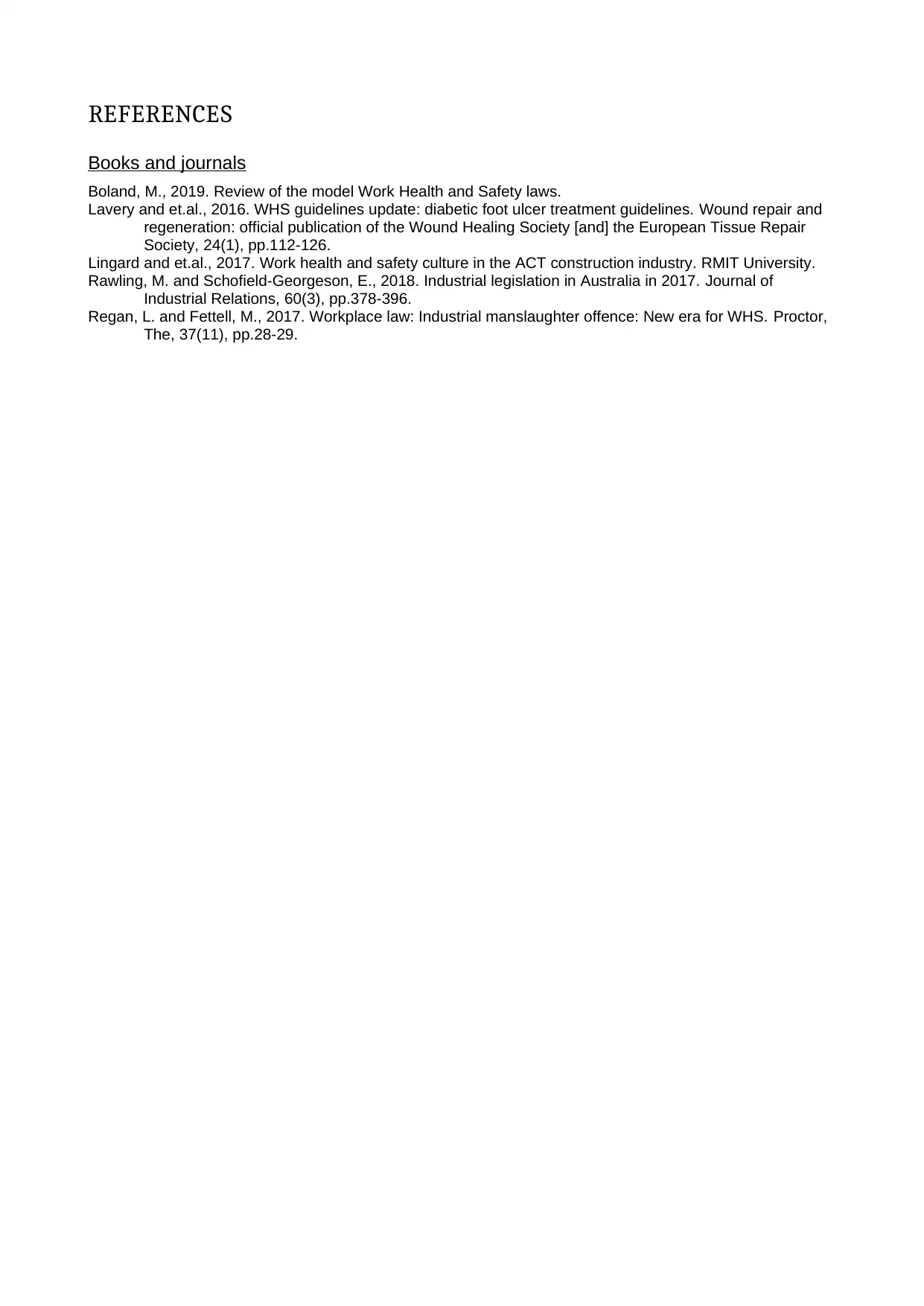
REFERENCES
Books and journals
Boland, M., 2019. Review of the model Work Health and Safety laws.
Lavery and et.al., 2016. WHS guidelines update: diabetic foot ulcer treatment guidelines. Wound repair and
regeneration: official publication of the Wound Healing Society [and] the European Tissue Repair
Society, 24(1), pp.112-126.
Lingard and et.al., 2017. Work health and safety culture in the ACT construction industry. RMIT University.
Rawling, M. and Schofield-Georgeson, E., 2018. Industrial legislation in Australia in 2017. Journal of
Industrial Relations, 60(3), pp.378-396.
Regan, L. and Fettell, M., 2017. Workplace law: Industrial manslaughter offence: New era for WHS. Proctor,
The, 37(11), pp.28-29.
Books and journals
Boland, M., 2019. Review of the model Work Health and Safety laws.
Lavery and et.al., 2016. WHS guidelines update: diabetic foot ulcer treatment guidelines. Wound repair and
regeneration: official publication of the Wound Healing Society [and] the European Tissue Repair
Society, 24(1), pp.112-126.
Lingard and et.al., 2017. Work health and safety culture in the ACT construction industry. RMIT University.
Rawling, M. and Schofield-Georgeson, E., 2018. Industrial legislation in Australia in 2017. Journal of
Industrial Relations, 60(3), pp.378-396.
Regan, L. and Fettell, M., 2017. Workplace law: Industrial manslaughter offence: New era for WHS. Proctor,
The, 37(11), pp.28-29.
1 out of 10
Related Documents
Your All-in-One AI-Powered Toolkit for Academic Success.
+13062052269
info@desklib.com
Available 24*7 on WhatsApp / Email
![[object Object]](/_next/static/media/star-bottom.7253800d.svg)
Unlock your academic potential
Copyright © 2020–2025 A2Z Services. All Rights Reserved. Developed and managed by ZUCOL.





